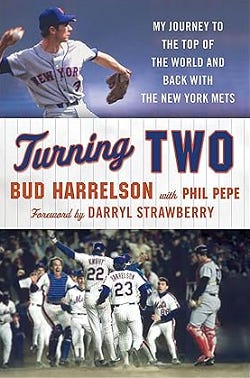The Miracle of Bud Harrelson's Final Baseball Card
That time three Mets tried to retire in Texas
Note: When you click on links to various merchants in this newsletter and make a purchase, this can result in this newsletter earning a commission. Affiliate programs and affiliations include, but are not limited to, the eBay Partner Network and Amazon Associates.
1981 Topps Bud Harrelson (#694) - Card of the Day
Bud Harrelson is a New York Mets legend, a member of the team’s Hall of Fame, and still among the all-time franchise leaders in several hitting categories. When most fans think about Harrelson, no doubt the Mets come to mind, too.
And the connection is strong enough that it works the other way for plenty of New York faithful — mention the Mets, and Harrelson is among the faces that spring from their memories.
But as deep as the Harrelson-Mets ties run, there was one thing that the Sheas couldn’t give their longtime shortstop, and vice versa — a career-capper baseball card.
The trouble on that front probably began in 1977, when the always light-hitting Harrelson took his game at the plate to new extremes. That summer, he hit .178 in 107 games and managed just a .482 OPS — that all translates to an OPS+ of 34, if you’re looking for a modern catchall explanation. Tough to stomach, even from a diminutive 33-year-old shortstop who was still a star in the field.
So that offseason, the Mets bought Tim Foli’s contract from the Giants, bringing their former number-one overall pick (1968) back where he started. With Foli penciled in as the starting shortstop for 1978, the Mets flipped Harrelson to the Phillies in exchange for infielder Fred Andrews.
In Philly, Harrelson took on a utility role, playing second base and shortstop, often as a defensive replacement. Ironically, he also appeared as a pinch hitter ten times, the most in his career, as well as coming in to pinch run several times.
After two years of such duty, the Phils cut Harrelson loose in April of 1980. The Rangers signed him as a free agent about a month later after former Mets teammate Rusty Staub went down with an injury. (Another former Met, Jon Matlack, was also waiting in Arlington to greet Harrelson.)
Harrelson appeared in 87 games for Texas that summer, all of them including innings at shortstop, where he tag-teamed with Pepe Frias.
But even though the veteran hit .272 on the year, Harrelson found no takers in free agency that winter. Topps must have thought he would be back, though, because they included him in their 1981 set, looking pensive…maybe even managerial.
Which turned out to be a fitting look, as Harrelson would return to the Mets for 1982, hired late in 1981 as manager George Bamberger’s new first base coach. Harrelson stuck with his team for the next ten years, as coach under multiple managers, and then as the skipper himself for parts of both 1990 and 1991.
That at least afforded him the chance to appear once again in Mets blue and orange from the cozy confines of a 2.5” x 3.5” hunk of cardboard (1991 Topps #261):
(affiliate link)
But that’s not a career-capper, and there’s no getting around that Harrelson’s last record-book entry as a player did not come with his beloved Mets:
(affiliate link)
But, hey, that last Topps card gives Mets fans — and the rest of us — another reason to celebrate one of the 1969 Miracles. Because, as you can see in the fine print, the late Derrel McKinley Harrelson was born on this day in 1944.
Jon Matlack Wants You to Come at Him, Bro
A year after Harrelson’s cardboard finale, Matlack graced one of the most captionable baseball cards of all time. I took my best shot(s) with 20 possible entries in this old post.
What do you think ol’ Trumpbour is saying here?
(affiliate link)








